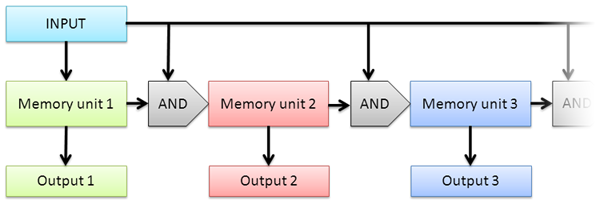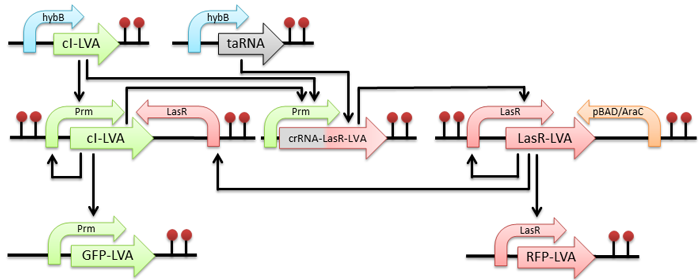Team:Groningen/Project
From 2011.igem.org
| Line 10: | Line 10: | ||
</div> | </div> | ||
| - | <div style="width: 80%; color: #000000; margin: auto; text-align: | + | <div style="width: 80%; color: #000000; margin: auto; text-align: justify"> |
| - | The aim of our project is to create a genetic | + | The aim of our project is to create a genetic device that will be able to count and memorize the occurrences of an input signal. This functionality will be achieved by the utilization of autoinducing loops, that will act as memory units, and interfering taRNA-crRNA system, which will act as an AND gate. Each increase of the counter will result in a different state of the system, that will result in an output signal. |
| - | + | The design of the device is modular. This means that both the input signal and the output signals can be changed freely, without disturbing the functionality of the memory system. Also, the design allows implementation of any number of memory units, as the AND gate design allows for a nearly hassle-free extension of the system, provided enough functional memory units. | |
| + | Because of that, the range of applications of our system can vary from the bacteria being used as a memory system of a Turing complete machine, through bacteria used as biosensors measuring the number of occurrences of an event in a ecosystem or in a process, to bacteria that can perform multi-step bioconversions sequentially all by themselves and without the need of changing them to another strain. | ||
[[File:Scheme1.png]] | [[File:Scheme1.png]] | ||
| - | ''The first input triggers the first memory unit (which consists of an autoinducing loop and a jammer-based off switch) to start. The first memory unit starts triggering the first AND gate. The second input triggers the AND gate. If the first memory unit is running, | + | ''The first occurrence of the input signal triggers the first memory unit (which consists of an autoinducing loop and a jammer-based off switch) to start. The first memory unit starts triggering the first AND gate. The second occurrence of the input triggers the AND gate. If the first memory unit is running, the AND gate triggers the second memory unit (which also consists of an autoinducing loop and a jammer-based off switch) to start. The second module starts triggering the second AND gate and represses the first module with the use of the jammer-based off switch. This process can be continued, if more autoinducing loops are provided. During operation, the system produces an output which depends on the current running memory unit.'' |
[[File:Scheme2.png]] | [[File:Scheme2.png]] | ||
Revision as of 11:59, 6 July 2011
Preliminary project description
The aim of our project is to create a genetic device that will be able to count and memorize the occurrences of an input signal. This functionality will be achieved by the utilization of autoinducing loops, that will act as memory units, and interfering taRNA-crRNA system, which will act as an AND gate. Each increase of the counter will result in a different state of the system, that will result in an output signal. The design of the device is modular. This means that both the input signal and the output signals can be changed freely, without disturbing the functionality of the memory system. Also, the design allows implementation of any number of memory units, as the AND gate design allows for a nearly hassle-free extension of the system, provided enough functional memory units. Because of that, the range of applications of our system can vary from the bacteria being used as a memory system of a Turing complete machine, through bacteria used as biosensors measuring the number of occurrences of an event in a ecosystem or in a process, to bacteria that can perform multi-step bioconversions sequentially all by themselves and without the need of changing them to another strain.
The first occurrence of the input signal triggers the first memory unit (which consists of an autoinducing loop and a jammer-based off switch) to start. The first memory unit starts triggering the first AND gate. The second occurrence of the input triggers the AND gate. If the first memory unit is running, the AND gate triggers the second memory unit (which also consists of an autoinducing loop and a jammer-based off switch) to start. The second module starts triggering the second AND gate and represses the first module with the use of the jammer-based off switch. This process can be continued, if more autoinducing loops are provided. During operation, the system produces an output which depends on the current running memory unit.
| Home | Team | Official Team Profile | Project | Parts Submitted to the Registry | Modeling | Notebook | Safety | Attributions |
|---|
 "
"


